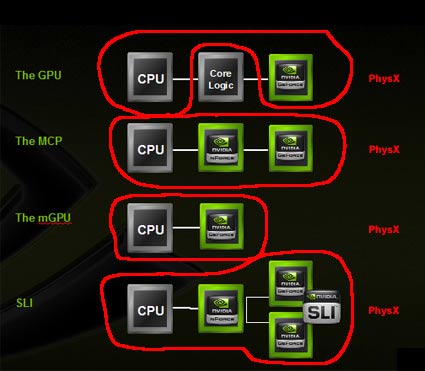Analysis: Nvidia's Ageia Purchase - A Brilliant Move?
Why Ageia matters
In order run physics effects on your PC today, you typically have to use the CPU, regardless of the platform you rely on. IBM's Xenon & Broadway, Sony Cell, Intel Core or AMD Phenom - all of these CPUs, however, have not yet shown that they can be capable physics drivers, so, in our opinion, specialized physics accelerators will be the solution for the future.
Even at Intel there is Larrabee, which is designed to become an all-purpose accelerator chip that is used for graphics as well as ray-tracing and physics, according to sources close to company. The second part of the equation is the development of next-generation game engines, which are going to drive implementation of real-world physics with next-generation consoles and PCs.
Let's look the public statements made in regards to the Nvidia-Ageia deal:
Nvidia released a following statement from Jen-Hsun Huang, co-founder and CEO:
"The AGEIA team is world class, and is passionate about the same thing we are - creating the most amazing and captivating game experiences. By combining the teams that created the world's most pervasive GPU and physics engine brands, we can now bring GeForce-accelerated PhysX to hundreds of millions of gamers around the world."
Manju Hegde, co-founder and CEO of Ageia, released the following statement:
"Nvidia is the perfect fit for us. They have the world's best parallel computing technology and are the thought leaders in GPUs and gaming."
True or not, the two statements refer to the present situation. But this deal was all about the future and controlling (or at least balancing) the world of physics computing, which set to march beyond the domain of games. Based on these statements, you might think that all currently-shipped GeForce products support PhysX, while the truth is that PhysX will be implemented in future chips, destined to be shipped in the hundreds of millions. Suddenly there is a pretty good reason for developers and publishers to jump on PhysX immediately.
Following the acquisition yesterday, we had the chance to talk to Tim Sweeney, founder of Epic Games and the brain behind the Unreal engine. Sweeney said that "we've had a great relationship with the Ageia team for years, and bundle their PhysX library with Unreal Engine 3 as its standard physics solution." He added that he was "happy to see Nvidia jump in and throw its massive weight behind physics."
Sweeney mentioned that he is planning to use Ageia physics features with "future Unreal Engine 3 games on all platforms."
The "all platforms" note is particularly interesting. Hidden away from the eyes of public, engineers are creating next-generation Xbox, next-gen PlayStation and next-gen Wii titles. We managed to find out that all creative spirits of these projects are now hidden in caves, working hard on getting the new silicon for future parts. You can expect that new wave of consoles comes will come to market in the 2010/11 timeframe, even though conservative estimates are talking about 2012 at this point.
But, clearly, Nvidia's mention of "hundreds of millions of gamers" was a signal for the IT industry as whole. It will be driven in all major graphics application markets. When it comes to PC itself, Nvidia has several plans, seen in this author's 2nd grade MSPaint skills in the picture above. The future is in physics being rendered on Nvidia's integrated chipsets and graphics cards.
The key to this strategy is not to think just about Intel or AMD processors, but a bit wider than that. If we are listening to the "rumors that could be true" department, we should to pay attention to the next-generation Sony console, which may integrate physics capability directly into Nvidia's GPU, which reportedly is not going to be the last-minute patchwork Nvidia had to deliver with the PS3 RSX GPU.
What makes this deal a sensible solution is the fact that Ageia has the engineers to take advantage of Nvidia's future hardware. You can bet the farm on the fact that future GPUs will have substantial input from Ageia's staff in terms of effectively channeling: Current GPUs have a deadly flaw in GPGPU terms - there are substantial performance penalties when branching is used.
At the other hand, CPU and PPU excel in branching, because there is enough cache to put
"what-if" instructions and correctly predict what could happen. Intel knew that and is building Larrabee with massive cache in the middle, while Nehalem, Westmere and Sandy Bridge will continue to increase the overall amount of cache, while re-introducing Hyper-Threading, enabling up to 16 threads on a single socket.
It is too early to say what will be the first GPU influenced by Ageia's engineers, but we expect that some influence might already be seen in the high-end graphics chip coming in 2009.
Get Tom's Hardware's best news and in-depth reviews, straight to your inbox.
